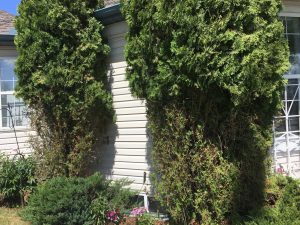
I live in Calgary and have managed to grow two gorgeous cedars in the east side of my home for the past twenty years. This past horrific winter, mule deer came into our neighbourhood for the first time, to forage, and made a beeline for my cedars. They are looking quite ragged from the ground to around five feet. Someone suggested I prune the tops, which are above eaves level by around four feet, and that would help the energy to be redirected to the bottom. Is this correct? I’ll do anything to bring them back.
From your photo, it looks like many of the lower branches at least survived the grazing! Since cedars regrow from new growth (not from old wood), if the deer ate much of the following year’s buds/green growth– the lower branches won’t grow back in these areas right away – they will likely start to fill in soon, and take at least a couple of years to look “normal” again. Note that even if the deer had stripped all green growth at the lower level of the trees, and this area of the tree had died (as the older wood does not produce new growth), the trees likely would have survived — as the top portions of the trees remain intact & and are thriving (more on that scenario below).
You can prune the cedars by removing as much as 1/3 of the foliage every year, to bring the shape under control. If you prune the tops, more sun can reach the cedars’ lower branches, encouraging growth. Don’t be too liberal in taking the tops off the cedars, though – remove under ¼ of the height, since the tree will grow slowly from the top. It may take a few years for the cedars to regain their old majestic shape.
The Laid Back Gardener’s Can you save a deer-damaged cedar hedge? includes a photo that clearly shows how severely deer can damage cedar hedges. This article addresses the need to figure out a way to prevent the deer who return next winter for a cedar banquet, from feasting again– e.g., use of a deer-proof barrier. The author also provides interesting suggestions as to what to do if the bottom branches of the cedars have indeed died and won’t regrow ( e.g., if there is no evidence of growth in these areas by the end of June – I don’t think this is the case for your trees, from your photo).
As well, a few postings on the Toronto Master Gardeners website will be of interest:
- Cedar hedge (May 2017) — the links provided in the post are excellent – well worth a read!
- Emerald cedar foliage eaten by deer – a case where we were doubtful that the foliage would regrow to cover all the browned areas.

